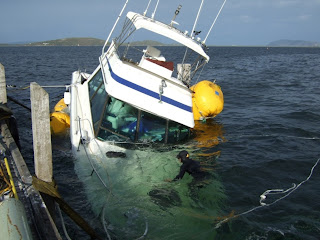 Standard Powerboat bilge systems usually consists of a bilge pump at the lowest point of your boat (below the floorboards). I guess that works for most powerboats, but today's faster higher priced boats and yachts may need more than that. When up on plane, most of the bilge water moves to the aft area and can dig your stern deeper into the water extending your draft and stealing your fuel economy! Let's take a look at what you can do...for your fuel economy and safety.
Standard Powerboat bilge systems usually consists of a bilge pump at the lowest point of your boat (below the floorboards). I guess that works for most powerboats, but today's faster higher priced boats and yachts may need more than that. When up on plane, most of the bilge water moves to the aft area and can dig your stern deeper into the water extending your draft and stealing your fuel economy! Let's take a look at what you can do...for your fuel economy and safety.Make sure your present bilge pump system is set-up properly, with installation of your pump, auto switch, and wiring in good order. A 1500 to 2000 gallon per hour primary pump for most midsize powerboats is fine. I like to hook up a "Buzz" alarm, (like your low oil pressure alarm) to the bilge pump system so I know how often it goes off. You can also have a light on your steering console that illuminates each time the bilge pump turns on. Knowing the bilge pump is running quite often, let's you know something is not right. A prop shaft packing could have failed, a through hull hose or hose clamp could have come loose causing water to enter the bilge. With the alarm sounding frequently, you are motivated to get into the bilge to find out why before it gets out of hand. I also set-up an additional bilge pump (3000 to 3500 GPH) with a float switch higher up as a back-up in case the primary fails or even worse, the primary can't keep up with the water coming into the bilge! It gives you a sense of security with this sort of set-up.
Now when you're on that plane, humming along...it is good to have a small bilge pump installed in the stern area to get out any water that accumulates there. You can have it on an automatic switch or just a manual switch...it's your choice. Power boating inshore to those fabulous harbors for the weekend with friends and family, or powering offshore for big game fishing, having this sort of bilge pump system helps keep you on top of things. Even at dock when you are away, an alarm sounding constantly from your powerboat brings attention... Happy Cruising!